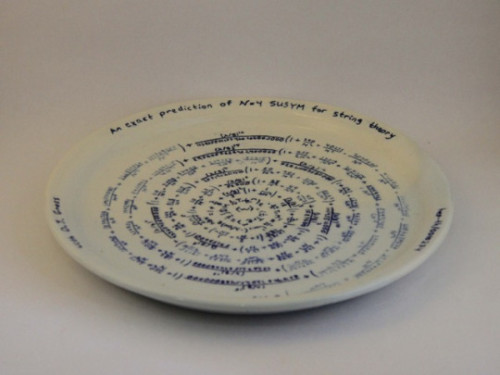
Showcasing science – one of the ceramic items created by Nadav Drukker on show at the new Quantum Ceramics exhibition in London. (Courtesy: Nadav Drukker)
By Matin Durrani
You might not think theoretical physics and pottery have much in common. But they do now, thanks to a new exhibition being staged at the Knight Webb Gallery in Brixton, south-east London, which opens today.
Entitled Quantum Ceramics, the exhibition is the first solo display of ceramic works by theoretical physicist Nadav Drukker. Based at King’s College London, Drukker makes traditional studio pottery as a new way to communicate his scientific research.
Drukker, who is a string theorist, has six different projects – entitled “Circle”, “Cusp”, “Index”, “Polygons”, “Cut” and “Defect” – with each inspired by one of his research papers. His works are all traditional glazed stoneware and porcelain vessels, but decorated with mathematical symbols.
I naturally wondered how Drukker got involved in ceramics and he told me it all started during the final year of his PhD, when he spent time at the Institute for Theoretical Physics in Santa Barbara in California.
Looking for a hobby to get away from doing physics all the time, a friend recommended pottery classes that were held in what Drukker describes as “a beautiful location on the bluff overlooking the ocean”.
But when the friend stopped going, Drukker stuck with it. “I’m glad I did!” he says. And what started off as a pursuit for a new social activity soon turned into a serious hobby.
However, after many years producing traditional pottery, cups, vases, planters and so on, Drukker started looking for a new challenge.
“Many people asked me how physics and ceramics are related and I finally decided to address the question, and the easiest answer is me; I create both,” he explains. The result is a series of ceramic artefacts with equations on them – pots with maths if you like.
“For each research project that I am engaged in, I choose a form that is somehow related to the science,” Drukker explains. “Early ideas and drafts, some of them crude and some even ultimately false, are depicted on a rugged pots with rough inscriptions, highlighted or possibly obscured by the glaze. Later incarnations of the ideas – better formed, more polished, and hopefully more accurate – are depicted in finer ceramics, using for example using higher-quality clay.”
Drukker admits it’s been a long process learning to write equations and text in clay and, more importantly, getting to some meaningful representation of scientific ideas in these decorated pots.
“Rough ideas may be scattered around the pot, while finer ones could be a spiral climbing from the references to the top of the piece, mirroring the finger marks I leave when working on the wheel,” he adds.
Drukker even engraves on the base of each piece the ID numbers of any scientific articles on arXiv referenced in the relevant paper. But be warned: there are many other details of the physics encoded on the pots as a “riddle” for the viewer to decode.
Quantum Ceramics runs until 8 April.
Guidelines
Show/hide formatting guidelines
this text was deletedwhere people live in harmony with nature and animals</q>
Some text